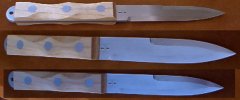What a night, I couldn't sleep last night. I laid in bed thinking about heat treating all night. I must have thought it through the process 40 times last night. I would have been better off getting up and just finishing the blade at midnight.
Fired the forge up at about 5:30 and brought the blade up to red. I suspended a natural magnet from the ceiling on a copper wire. At first it wasn't hot enough. I got it hotter, its really cool how the magnet ignores the steel when its up to temp. I laid it aside to normalize....
I had a harder time getting my quenching oil up to temp than I did the blade....I normalize again waiting for the oil.
Finally everything was set.....heated the blade up again...a pass by the magnet...everything fine.... back in the forge for one more minute and then the quench.
A little smoke but no fire. I put a little soft mechanics wire through the thong hole so I could pull it out of the oil.
In about 20 minutes I pulled the blade out, let it drain a few seconds and then pulled it up to look at it.
I STRONGLY SUGGEST EVERYONE TO TEST THEIR FRESHLY QUENCHED BLADE BY DROPPING IT FROM EYEBALL HEIGHT, POINT FIRST, DOWN TO HARD COLD CONCRETE.
This test is also proves the law of gravity because your blade, your heart, and other precious bodily appurtenances all hit your concrete floor at the same time.
A piercing pinggggggggggggggggggggggggggg rang through the quiet neighborhood.
Absolutely no harm to the blade......whewww!.
What had happened was the wire straightened out during the forge trip (DUH).
I then triple tempered it at 420-430 degrees.
I had my handles ready to go and it only took about an hour to finish it.
Here's a pic. A little stain on the Hard maple handles and a sheath will be forthwith.
Loosenock
Fired the forge up at about 5:30 and brought the blade up to red. I suspended a natural magnet from the ceiling on a copper wire. At first it wasn't hot enough. I got it hotter, its really cool how the magnet ignores the steel when its up to temp. I laid it aside to normalize....
I had a harder time getting my quenching oil up to temp than I did the blade....I normalize again waiting for the oil.
Finally everything was set.....heated the blade up again...a pass by the magnet...everything fine.... back in the forge for one more minute and then the quench.
A little smoke but no fire. I put a little soft mechanics wire through the thong hole so I could pull it out of the oil.
In about 20 minutes I pulled the blade out, let it drain a few seconds and then pulled it up to look at it.
I STRONGLY SUGGEST EVERYONE TO TEST THEIR FRESHLY QUENCHED BLADE BY DROPPING IT FROM EYEBALL HEIGHT, POINT FIRST, DOWN TO HARD COLD CONCRETE.
This test is also proves the law of gravity because your blade, your heart, and other precious bodily appurtenances all hit your concrete floor at the same time.
A piercing pinggggggggggggggggggggggggggg rang through the quiet neighborhood.
Absolutely no harm to the blade......whewww!.
What had happened was the wire straightened out during the forge trip (DUH).
I then triple tempered it at 420-430 degrees.
I had my handles ready to go and it only took about an hour to finish it.
Here's a pic. A little stain on the Hard maple handles and a sheath will be forthwith.
Loosenock

